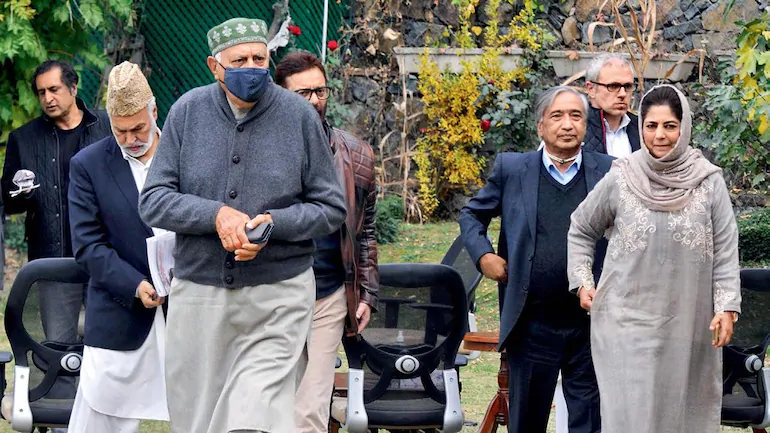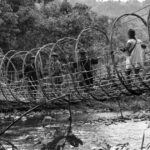
SOURCE: INDIA TODAY
On November 7, the People’s Alliance for Gupkar, a coming together of seven mainstream political parties in Jammu and Kashmir, announced that they would jointly contest the District Development Council (DDC) elections, scheduled from November 28. It’s an unprecedented decision by political parties often bitterly opposed to each other, now making common cause in an attempt to resist the Centre’s plan to script a political future for J&K that will further undermine their role in it.
The DDC elections come 15 months after the abrogation of Article 370 and the bifurcation of the state of J&K into two Union territories on August 5, 2019. The last elections held were the panchayat and urban body polls in 2018 which the National Conference (NC) and Peoples Democratic Party (PDP), the main politcal players in the erstwhile state, boycotted, effectively handing the BJP a walkover.
This helped the BJP wrest control of the local governance system in the Valley, where it had never won any poll of significance. The Gupkar Alliance leaders want to make sure they don’t make the same mistake again. The 20 DDCs, each led by a chairperson (who may be vested with junior minister status), will have a five-year term and appear designed to curtail the powers of elected representatives of any future legislative assembly in J&K.
“The sudden announcement of the polls revealed their plans. They want to cut us off from the people but we won’t allow it,” says Gupkar alliance signatory and senior CPI(M) leader Mohammad Yousuf Tarigami. “Our agenda is the restoration of the constitutional position as existed on August 4, 2019, but that does not bar us from participating in an exercise in public interest.”
The decision was not easy. Multiple factors, especially how the move would go across in Kashmir, was a concern. But almost everyone they consulted was of the opinion that they should not cede unopposed space to the BJP. There were other issues too. NC president and Gupkar Alliance chief Farooq Abdullah says they could not get a common election symbol as elections had been announced all on a sudden. “We will field joint candidates and they will use their respective party symbols,” says the 84-year-old former J&K chief minister and MP.
The BJP has announced candidates for the polls, but many in the party are sceptical about their prospects now. A state unit leader says even without the NC-PDP and others jumping into the fray, the people would have baulked at voting given the public antipathy over recent policies like the new land laws. “Even my children will be affected by this,” says a BJP office-bearer pleading anonymity. “I can’t understand what they (the leadership) are up to.”
One of the major poll issues is likely to be the order issued by the Union home ministry on October 26, the Union Territory of Jammu and Kashmir Reorganisation Fifth Order, 2020, repealing 11 land laws and opening up land and property ownership in the UT to all Indian citizens. Earlier, only Permanent Resident Certificate holders or state subjects defined by a law introduced by Dogra king Maharaja Hari Singh in 1927 were entitled to buy and own movable and immovable property. The same state subject law was replicated in the Constitution (Article 35A) through a presidential order in 1954, which allowed the J&K legislature to define ‘permanent residents’.
The new land laws have created disquiet in not just the Valley but in Jammu too. This is quite evident on the streets as well as on social media. Soon after they were introduced, protests broke out in Jammu while a call of the Hurriyat Conference shut down the Valley on October 31. Hurriyat leader Mirwaiz Umar Farooq, who is still under house arrest, broke his silence for the first time since August 5, 2019 and called for the strike against the “anti-people orders”.
Initially, when Parliament ‘fully integrated’ J&K last year, Jammu played a big role in the bid to legitimise the decision. There were celebrations in many parts, denoting an end to what they felt was the Valley’s ‘dominance’ in the administration and politics. But gradually realisation dawned that the new state of affairs was diluting their Dogra identity, leaving them more vulnerable to outside influx. “Hamara itihaas khatam kar diya (Our history has been destroyed),” says Sunil Dimple, a Jammu resident and president of ‘Mission Statehood’. He is garnering support for restoration of statehood and special status. Dimple now regrets that Jammu stood with the BJP and brought them to power in the 2014 assembly election (25 seats) and 2019 Lok Sabha election. “The new law is like an advertisement to bring people from outside. Like the East India Company looted India, they (the BJP) have opened the doors of J&K to big business houses,” he says. “They don’t want the people, they want the land.”
The J&K government, however, disagrees. Government spokesperson Rohit Kansal insists the “new land laws will not only afford protection to over 90 per cent of the land in J&K but will also revamp the agriculture sector, foster rapid industrialisation and create jobs in J&K”. Kansal says the old laws had scope for discretionary interpretation and rent seeking. J&K lieutenant governor Manoj Sinha also clarified that agricultural land has been reserved for farmers. “No outsider will come on those lands,” he says. “But we have also defined industrial areaswe want industries to come to J&K so that it develops and jobs are generated.”
The Gupkar alliance, though, rejects these assurances. The real objective, they say, is to effect a “demographic change that will only disempower the local population”. Tarigami points out that the BJP is only targeting J&K while there are exclusive land rights laws in Himachal Pradesh and the Northeast too. “We will approach the courts and every other forum to repulse these pressures from the Government of India,” he says.
Before the new land laws came into being, the J&K High Court, on October 9, struck down the J&K State Land Act (vesting of ownership to occupants) 2001, commonly known as the Roshni Act. It declared the act “unconstitutional” and ordered a CBI probe into the wrongdoings in implementation. All land allotments under the act were declared “void ab initio from its very inception” (see What is the Roshni Act?).
The BJP has also introduced a communal angle to it, saying the “land jehad” was aimed at changing the demography of Jammu. Senior BJP leader and former deputy CM Kavinder Gupta even saw a Pakistan hand in it. But Jammu-based lawyer Sheikh Shakeel Ahmad, who filed the original petition in the high court challenging the encroachment on state land, calls it a false narrative. To cite an example, he says 44,915 kanals (1 kanal=550 sq. ft approx.) of land were regularised in Jammu district under the Roshni scheme; only 1,180 kanals were distributed among non-Hindus. “They are running a narrative that is factually incorrect,” says Sheikh. “This is just meant for the elections.”
WHAT IS THE ROSHNI ACT?
J&K State Land Act (vesting of ownership of land to occupants) was promulgated by the Farooq Abdullah government in 2001. It was to generate a Rs 25,000 crore corpus to fund power generation, hence the ‘Roshni Act’
Initially, the act set 1990 as the cut-off year for regularising private ownership of state land occupied through encroachment, on payment of prevailing market rates. The cut-off date was later relaxed to 2004, and then 2007
In 2014, the CAG found gross irregularities in the sale of land including reduction in prices to benefit politicians and other bigwigs. Report indicted officials but no further action was taken
In 2014, Ankur Sharma, who heads Hindu right-wing group Ikjutt Jammu, challenged the Roshni scheme in court, blaming it for a “demographic invasion of Jammu”
In October 2020, the J&K high court declared the act unconstitutional and ordered a CBI probe into wrongdoing. All land allotments/ ownerships vested under the act were declared void
The government said it would evict the “encroachers” in six months, triggering speculation that the huge land bank, 348,160 kanals were transferred over the years, created through this attachment of property would be sold to outsiders.






